
The gold of the Alhambra
After discovering the site beyond the cemetery of San José, I was able to confirm one of the greatest truths that every Granadan knows first-hand. It so happens in Granada that surprise lurks just around the corner. You are downtown, in the geographic center of Granada, and just by taking a bus, in five minutes you get to a spot where as if centuries had not passed, you might almost hear the slaves of the last Roman consul, digging holes in the mountain so as to provoque the ruina montium, that is to say, the collapse of the mountain that will enable the filtering of the earth to obtain its precious treasure. Gold. That gold whose existence in the river Darro’s banks (the ‘Dauro’ which ‘gives gold’ as Romans baptized this river) was well-known and it was the talk of the town through tales and fabulous stories of treasures hidden in uncharted enclaves.
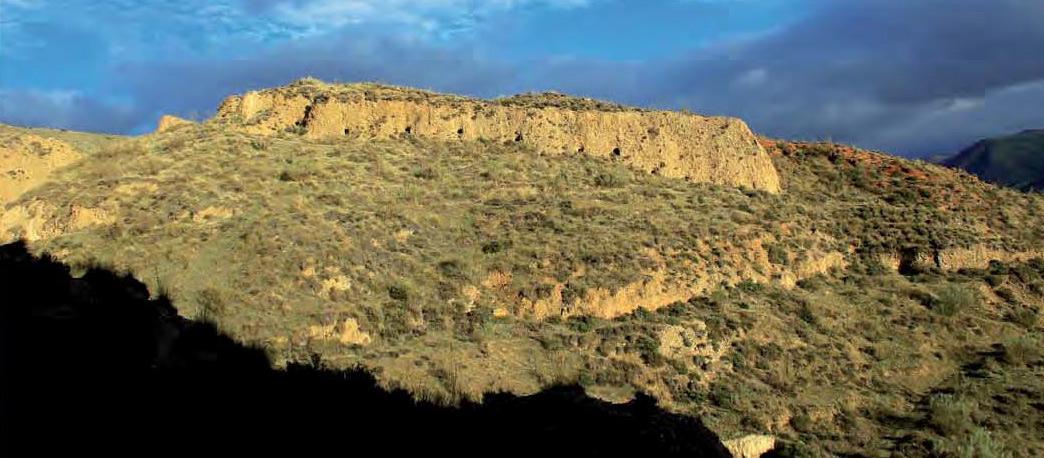
The treasure was not hidden though. The treasure is the very mountain, which, as if it was a boat stranded in the high seas, was getting into the fertile plain of Granada over millions of years, carrying forward millimetre-thick pieces of the precious metal along with agglomerated sandstone, slate, quartzites and gravel.
Two rivers, the Darro and the Genil, wash the banks of the mountain of the Alhambra. That is why the prized little leaves of gold are exposed along some parts of its route. It was in the Darro River banks where the existence of gold was always known, given the striking presence of the “aureanos”[1] searching for gold at the foot of the Albayzin quarter. The low price of gold during the 19th and 20th centuries turned these men into poor romantics to whom the jewellers of Reyes Católicos Street paid a little bit more for keeping on doing the task like starving titans. Reumathism, progress and immigration wiped them out from wipe the course of this legendary river. But there was another river, auriferous too, to which nobody paid attention. But there was another river, auriferous too, to which nobody paid attention.
Nothing was known from those who searched for gold on the other bank, that of the Genil River. There was gold in other spots like the Cerro del Oro (Golden Hill) in Cenes, in the Granadan quarter Bola de Oro (Golden Ball), or the Road of the Filtros (Filters) in Lancha del Genil, and there were gold-seekers in those places too. With the passing of time, they were taken for madmen or dreamers. Yet they knew, as reported in a NO-DO (Noticias and Documentales, a Spanish cinematographic newscast) in 1952, that gold was abundant there, near Lancha de Cenes (today renamed as Lancha del Genil). And it is still waiting there.
It may be questioned why the city has remained over the centuries aloof to the huge treasure that is just there, behind the Alhambra, next to the course of the Genil River. This was also known to the French, who searched for it on the other bank, that of the Genil River, where it is easier to extract the metal, for as it was a mountain, the ground was more abundant. Despite all this, nobody would remember those lost mines all thorugh the 20th century.
In order to understand this enigma in the city of oblivion, we must approach the Granadan neighbourhood of Lancha del Genil, known as Hoya de la Campana (Bell’s Basin). It is an easy way. You take a walk to get to the Fuente de las Batallas. Take the bus number 33. The itinerary is short, some 5 minutes, which allows us to enjoy the wonderful view of the Promenade of El Salon and the Genil River. You are already on your way to Sierra Nevada, and once you get to the limit of the village of Cenes, you leave the bus and then you find an imposing gold mine, with its cuts and tunnels, in front of you, as well as never-ending treasures of history and, if you have time to filter the ground, even pure, 24-carat gold.
[1] Aureanos, the name given to the gold prospectors in the Darro River.
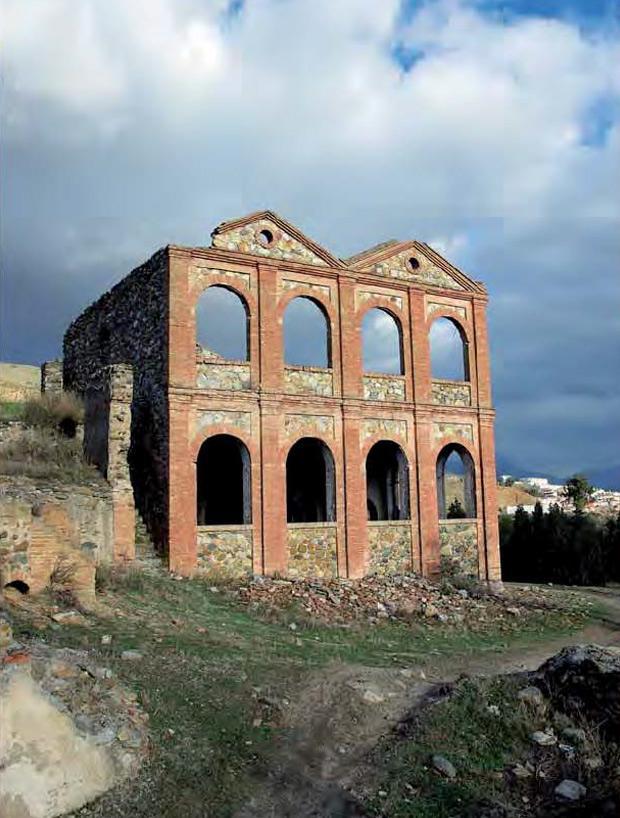
View of the wholes that resulted from the collapse of the mountain caused by the strength of the water. This spot is known as Hoya de la Campana (bell sinkhole), as its orography recalls an inverted bell.
In that place there is an abundance of the metal, but not of vegetation. Some 300 acres (double if we add the gold fields of the neighbouring village) of dry land are traversed by two seasonal streams. The name, Hoya de la Campana (Bell’s Basin) is accurate, for you can actually believe that what you see is an inverted bell whose inside looks up to the sky. It was the hand of Man who made this change in nature. Where today we can see this deep deppresion of the terrain, there was once a huge hill, which was the extension toward the Valle del Cerro del Sol (The Sun Hill Valley), that southern bastion of the Llano de la Perdiz, as it is popularly know by Granadians, and also called Parque de Invierno (Winter Park). In that place there is pinewood in the heights, and esparto and rosemary in the lower areas. And some traces of fires, which here are abundant.
The first extractions were undertaken by Romans, as we have said before. They even built a canal to carry water to the site from the River Darro. Remains of that aqueduct can still be seen, in the same way as the marks on the walls of that brilliant invention which was used to break down the hill in times when nor powder nor dynamite existed. We can find a perfect example of the ruina montium system in Las Médulas (León), with regards to what Pliny the Elder wrote in the 1st century B.C in his work Naturalis Historia, which was also quoted later on by Strabo in the 1st century of our era.
The ruina montium system was used to get directly to the gold vein. The mountain was pierced at different levels by an army of slaves who, pick in hand, by the faint light of the oil lamps (lucernas), digged tunnels while, on the top of the hill, the water that was brought for that purpose was at the same time collected. In the Granadan mine we can see the remains of this type of mining exploitation, in the wholes in the vertical walls of the hill which enclose the already mentioned basin of the site. In the same way, some ground heaps located half way to the mountain, in the upper part of the mine, show where the post-filtering after the scree occurred.
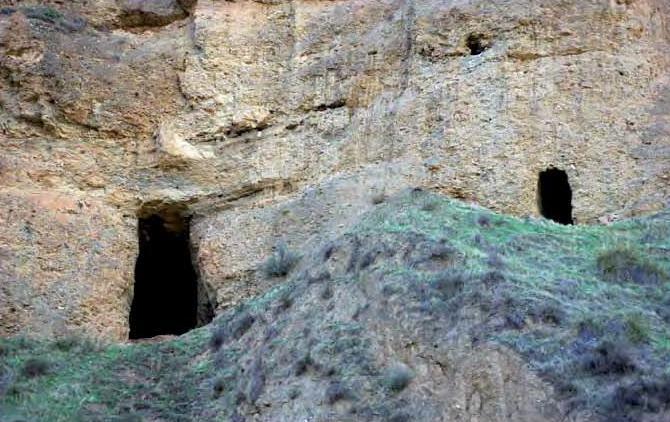
A little further down, next to the path that covers this territory like a scar, we can see the area where scholars have stablished the location of what might have been a small pond where the Arabs placed the captives that, in groups amounting to five hundred men, were taken to the mine to undertake the hard work of the gold filtering. Authors like Ahmad al-Razi (889-995), and later on Ibn Hazm (994-1063) or Ibn al-Khatib (d. 1375) mention the existence of gold extractions in the southern side of the Genil River.
During the period of Christian domination, the gold issue was silenced, since the Catholic Monarchs and their successors, as they had notice of the existence of the precious metal in their dreamt Alhambra, ordered the prohibition of its extraction, which became an exclusive activity of the crown. Despite the subsequent reports sent to the monarchs by their administrators (as it is the case of Hernández de Zafra or the marquises of Mondéjar or Campotéjar) about the existence and convenience of its extraction, this was merely anecdotal or occasional. In this way, the gold affair went unnoticed over four centuries, up to the 20th century.
From 1850 a true gold rush resulted in the registration of many mining rights over the red soils of the higher part of the Alhambra (Cerro del Sol) and beyond the village of Dílar. In 1858 there was talk of the “Granadan California” in allusion to the gold in the alluvial deposits nearby the city. The epicentre of that collective madness was placed in the Barranco (ravine) de Doña Juana, in the village of Huétor Vega, where people from all the corners of the country toiled over months searching for the precious metal… with scarce luck, but enough creativity so as to invent the most varied machines to extract the coveted golden dust.
The mining engineer Tomás Sabau described what he saw in Granada in 1850: “And how to stop the greed of some, the interest in the capital gains of others, and the curiosity of all, when hearing or reading the hyperbolic expression of “Californias of Granada”? “Everywhere you hear about gold: on the streets and walks, in the coffeshops, in the private homes” […]; “people come to the Barranco (ravine) de Doña Juana, three quarters of a league away, where the people from Huétor Vega are washing their clothes; and to the Barranco (ravine) Bermejo, where the Granada Gold Society, the only one showing signs of life to date, has mounted a testing machine according to the new procedure of M. Julio Napoleón Simyan; and when they see that only by washing the sands in big wooden pans, some grams of gold, of a bigger or smaller size […] , are obtained, they enthusiastically harbour the greatest illusions, and they all think about discovering the ‘primitive breeding ground’ which is the golden dream of all these people”.
That Granadan-style gold rush led to meetings in the coffee shops to tell the nearest ones the last inventions of a machine that could extract the very fine gold from the thick sand, although most of those gadgets were merely big wooden and metal hulks which soon proved their inefficiency for such a difficult task.
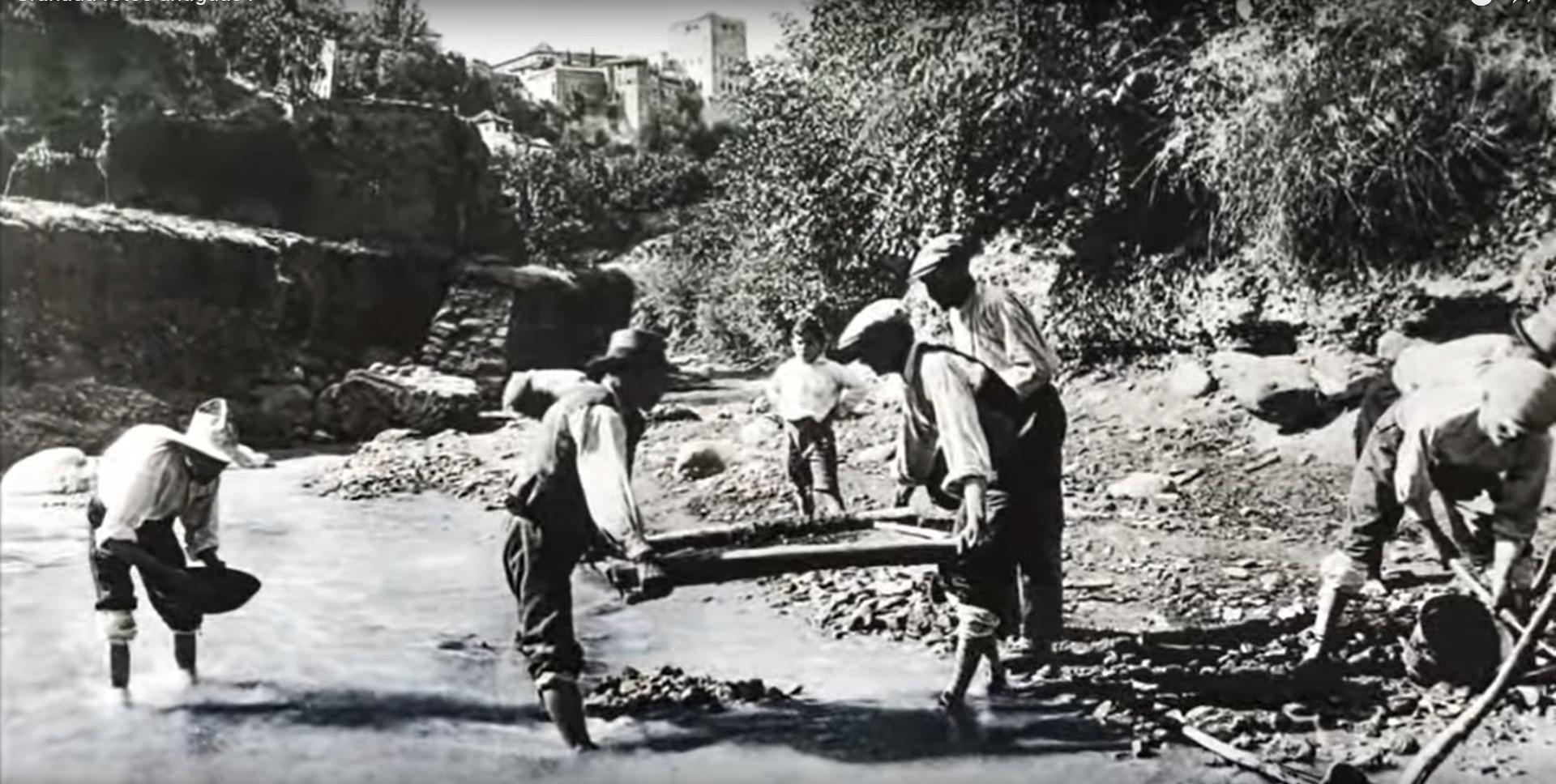
The gold prospectors in the Darro River, at the foot of the Alhambra, in a picture from the early 2oth century.
The most decisive endeavour in the last century was undertaken between 1875 and 1877 by the Parisian art dealer Adolfo Goupil, who managed to build a whole mining city in the hamlet of Lancha, which included mining offices, housing for the workers, and even his own palace which included a Nasrid arch. Yet, as the gold vein was widely scattered on diverse valleys, vast amounts of rocks and sand had to be moved, which made the exploitation unprofitable, as the gold proportion was 0,45-5 g. per each cubic metre of moved soil.
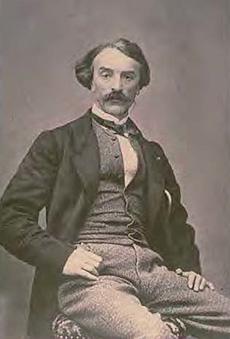
On the left, A la izquierda, Jean Adolphe Goupil, the Parisian art dealer behind the last gold adventure in Granada.
Goupil (who was the art dealer of Mariano Fortuny and Van Gogh, among others) died before having found gold in the expected amounts, although his mine had begun to be somewhat profitable when death overtook him. His sons, who lived in Paris, and were the heirs of one of the biggest fortunes of Europe, got rid of their father’s Granadan chimera straight away; they left here the memory of that gold rush which led Goupil to build a Gold Factory in the middle of nowhere.
The data of the gold prospecting provided by Goupil’s engineers was revealed at the Paris World Exhibition position in 1890, by Guillemin-Tarayre, in a presentation that took place during the first mining engineers international convention.
In the rough walls of the mine, we can still see how that way of extraction worked. It consisted of shooting a jet of water against the mine walls, a procedure that wore away the earth, and was taken at the same time to the lower section of the mine through wooden crates which helped also to make the selection of the minerals. This part of the process took place in the mine area closer to the current village of Lancha de Cenes, where one can still see a house with its walls half in ruins, named by the locals the “Factory of Gold”. There are still the remains of the tunnels containing the canalizations of gold, diverse pools where sand was separated, a big pond where sand was accumulated, and to which mercury was added to allow, by means of a chemical process, the gold to be separated from the rest of materials, and to be finally melted.
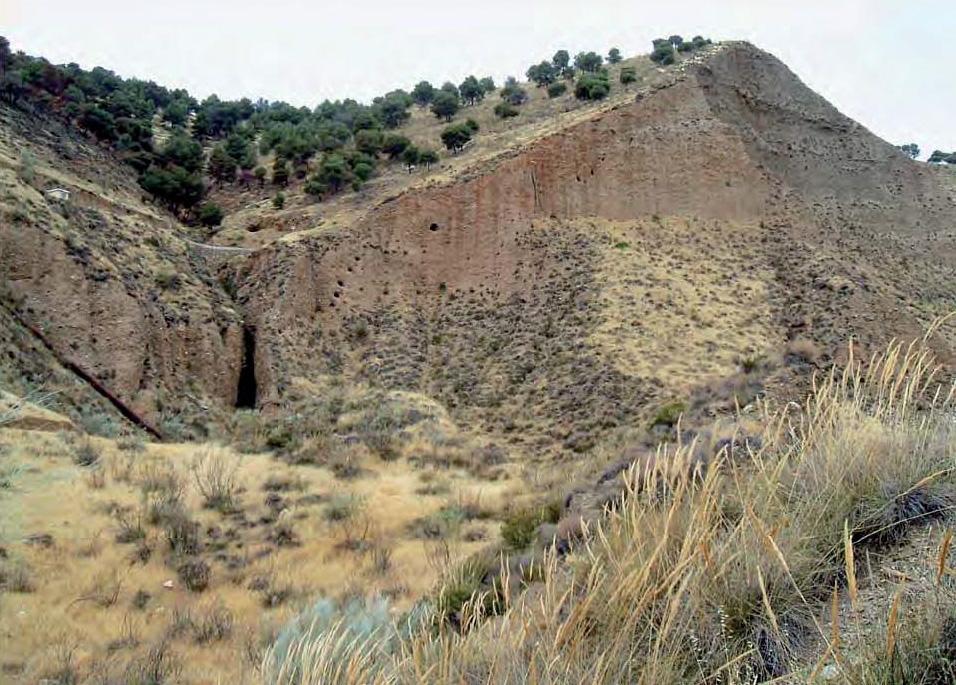
According to Tarayre, the gold amounts that the exploitation of the mine could give were a fact that was recently confirmed (in the sixties of the last century) by a Canadian mining company that once again evaluated the possibility of a massive extraction. According to Tarayre, the gold amounts that the exploitation of the mine could give were a fact that was recently confirmed (in the sixties of the last century) by a Canadian mining company that once again evaluated the possibility of a massive extraction.
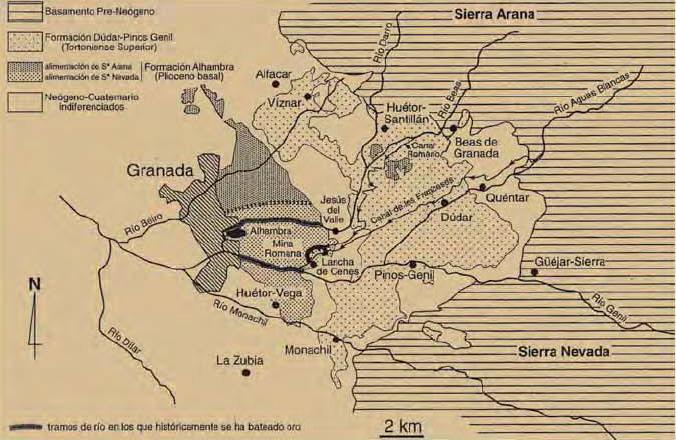
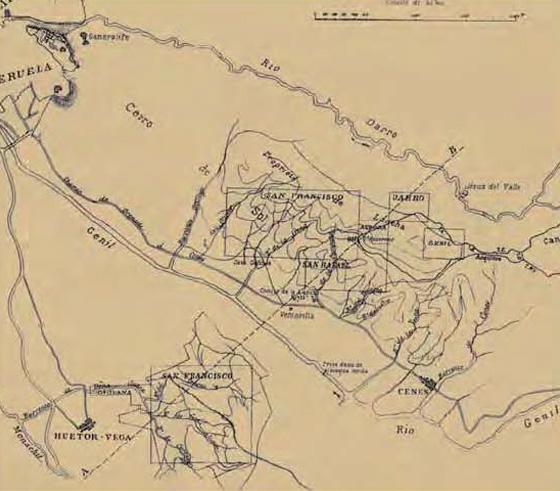
Yet the passion for the finding of gold did not decay among those who have always known of its existence in the areas including Dílar, Huetor Vega, Monachil, Cenes de la Vega and Lancha del Genil; such is the power with which men’s wills are lured by the golden charm. In this way, the newspaper from Barcelona La Vanguardia informed its readers on 3rd October 1975 that “the gold mine of Granada is profitable”. Following the analysis of the soil sample from the mine La Zapatera, in Dílar, nearby Granada, presented by Juan de Dios Martín Jiménez, undertaken by the Geological and Mining Institute depending of the Ministry of Industry, the content of pure gold is one kilo sixty grams per ton of ground. Mr. Martín Jiménez states that, despite having exceeded the double of the average amount needed for the exploitation being considered profitable, he has not started to work yet because the initial investment is very high, and he has not the necessary resources. He expects to get in touch with specialists, either belonging to the state or to public companies in order to reach an agreement on the exploitation of the mine, once the corresponding verification of the existence of the precious material is done.”
Many traces of the Goupil mining of gold, old and badly damaged, can still be seen in the place: the gold factory, with its pond and the different tanks for the metal repose; the subterranean canals and aqueducts; the dam under the mine, and some passages downtown the neighbourhood of Lancha that, according to villagers who have got into them, they lead, not only to the very mine, but even to the Alhambra. The palace of Goupil stands still in our days, and next to this Neo-Arab mansion remained an arched gateway dating to Mulay Hassan’s times that the French businessmen had brought here from the archaeological remains of the Casa de las Gallinas (House of Hens), a recreational estate that belonged to the king of the Alhambra. Yet, all this patrimony sleeps the sleep of the just, forgotten in a place where no-one ventures, unless to be amazed at the capacity of Granada to keep to itself treasures and stories, which ignite the gold of imagination, and that of illusion, the more genuine of all.
By César de Requesens Moll.
Journalist and writer.

